Eastern Chipmunk
Tamias striatus
The name chipmunk is derived from an Ojibwe word that means “one who descends the trees headfirst.”
Advertisement
Eastern Chipmunk Scientific Classification
- Kingdom
- Animalia
- Phylum
- Chordata
- Class
- Mammalia
- Order
- Rodentia
- Family
- Sciuridae
- Genus
- Tamias
- Scientific Name
- Tamias striatus
Read our Complete Guide to Classification of Animals.
Eastern Chipmunk Conservation Status
Eastern Chipmunk Facts
- Prey
- Insects and worms
- Name Of Young
- pup
- Group Behavior
- Solitary
- Fun Fact
- The name chipmunk is derived from an Ojibwe word that means “one who descends the trees headfirst.”
- Biggest Threat
- Predators
- Most Distinctive Feature
- The dark brown and white stripes down the back
- Gestation Period
- 35 days
- Litter Size
- two to five
- Habitat
- Urban and suburban parks, backyards, human habitations, deciduous woods
- Predators
- Foxes, bobcats, birds of prey, coyotes, dogs and cats, raccoons, red squirrels, mustelids
- Diet
- Herbivore
- Type
- mammal
- Common Name
- Eastern Chipmunk
- Number Of Species
- 1
- Location
- United States east of the Mississippi River and southern Canada
- Group
- solitary
Eastern Chipmunk Physical Characteristics
- Color
- Yellow
- White
- Dark Brown
- Grey-Brown
- Skin Type
- Fur
- Top Speed
- 18 mph
- Lifespan
- two to eight years
- Weight
- 2.33 to 5.30 ounces
- Length
- 10 to 12 inches
- Age of Sexual Maturity
- six months for females, eight months for males
- Age of Weaning
- 40 days
View all of the Eastern Chipmunk images!
“The eastern chipmunk is the largest of the chipmunks!”
To humans, chipmunks are small and cute. The eastern chipmunk is the largest of these cuddlesome rodents, and it can be tamed and make a fairly good pet despite its short lifespan. The actress Elizabeth Taylor had a pet chipmunk and even wrote a book about him. In the wild, chipmunks are antisocial and a bit predaceous on smaller creatures such as worms and bugs. On the other hand, every type of medium to large North American carnivore has chipmunks as part of its diet. Read on for more information about the characteristics and lifestyle of the eastern chipmunk.
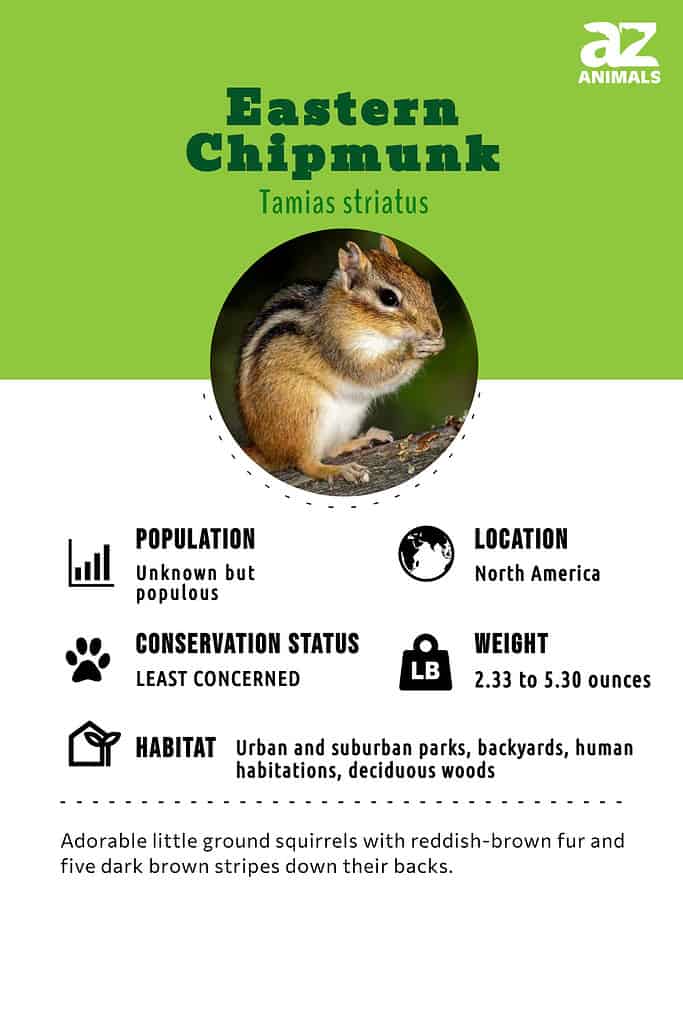
Four Incredible Eastern Chipmunk Facts!
Here are four amazing facts about the eastern chipmunk:
- Biologists believe that half of all chipmunks in a given area were born the same year that they’re being studied.
- A chipmunk can collect as many as 165 acorns in one day.
- The chipmunk’s cheek pouches are adaptations that allow it to carry lots of food to its burrow at one time. They are so stretchy that they can grow to three times the diameter of the animal’s head.
- The rodent doesn’t enter proper hibernation but a state called torpor. During torpor, the chipmunk’s heart rate can drop to four beats a minute. Normally, its heart rate is 350 beats a minute. Its body temperature also plunges from about 94 degrees to 40 degrees Fahrenheit.
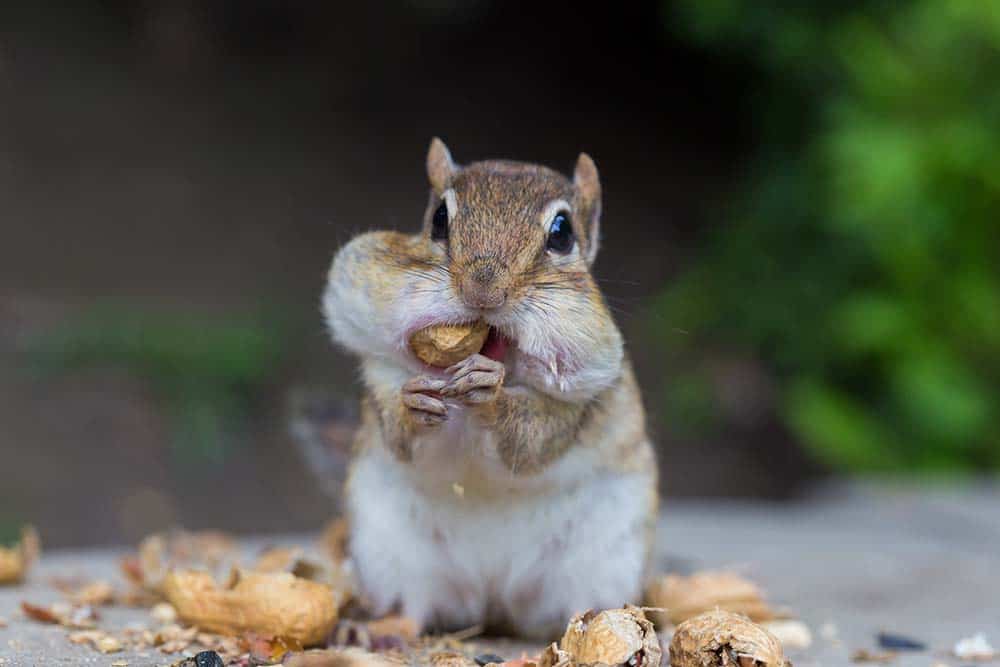
An eastern chipmunk’s handy cheek pouches can stretch to three times the size of its head.
©colacat/Shutterstock.com
Scientific Name
The eastern chipmunk belongs to the Animalia kingdom, the Chordata phylum, and the Sciuridae family to which most squirrels belong. Its scientific name is Tamias striatus. Tamias is Greek for “steward” and striatus is Latin for “striped.” The Tamias part probably refers to the chipmunk’s penchant for caching seeds to eat during the winter. The eastern chipmunk is the only living member of the chipmunk genus Tamaias. There are 11 subspecies, and they are:
- Tamias striatus doorsiensis
- Tamias striatus fisheri
- Tamias striatus griseus
- Tamias striatus lysteri
- Tamias striatus ohioensis
- Tamias striatus peninsulae
- Tamias striatus pipilans
- Tamias striatus quebecensis
- Tamias striatus rufescens
- Tamias striatus striatus
- Tamias striatus venustus
Evolution
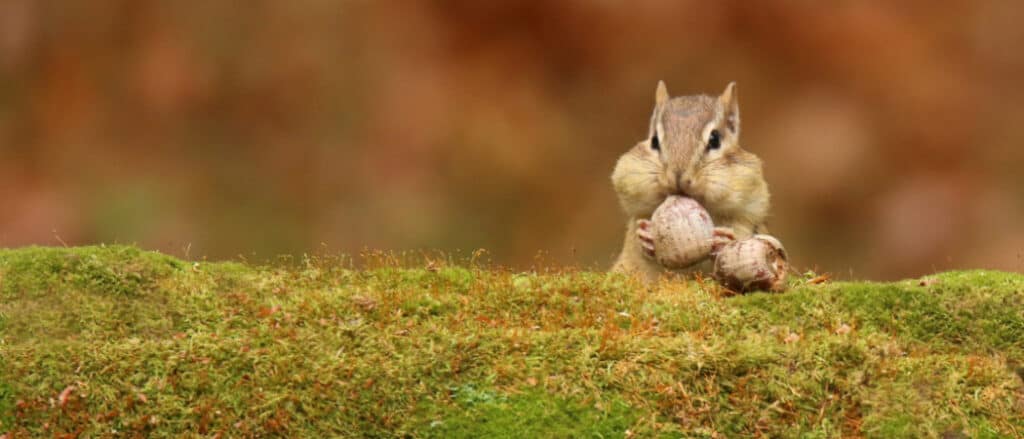
Chipmunks are a type of squirrel.
©iStock.com/suefeldberg
The earliest fossil evidence of squirrels (chipmunks are a type of squirrel) was found in western North America and dated around 36 million years ago. Six million years later – fossil records indicate that squirrels appeared in Europe. During that time the Bering Strait land bridge provided passage for many different species – including squirrels – from North America. Squirrels show up in African fossil records shortly after it collided with Eurasia about 18 – 20 million years ago. After that, squirrels evolved and adapted to their diverse environments – into the over 200 species known today.
Appearance
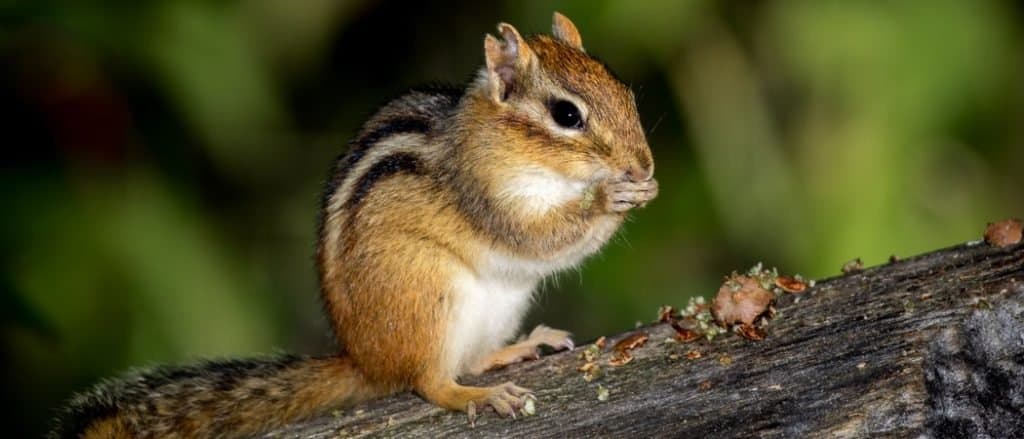
Eastern chipmunks are adorable little rodents with reddish-brown fur and five dark brown stripes.
©RT Images/Shutterstock.com
The identification of the eastern chipmunk is so easy that it’s tempting to think that everyone knows what it looks like. Familiar characteristics include its small size, though at up to 12 inches (including its tail) the eastern chipmunk is the largest of the chipmunks. It has a weight of between 2.33 to 5.30 ounces.
The colors of its fur are reddish-brown with five dark brown stripes down its back, with the longest one found in the center of the back. These dark stripes are separated by white stripes, and there are also lighter stripes around the chipmunk’s eyes and on its face. The stripes stop just before the patch of color on the rump, which along with its larger size differentiates the eastern chipmunk from others and is an aid in its identification. Its underside is white, and the patch on the rump is reddish or yellowish.
Other characteristics are small ears, big, bright black eyes, and two cheek pouches. It has a flat tail that is furry as opposed to bushy and dark in color. The chipmunk has four toes on its front feet. It uses its front feet and toes as hands and fingers when it eats. There are five toes on the back feet. Males and females are hard to tell apart until the mating season. The chipmunk also molts in early summer and fall.
Behavior
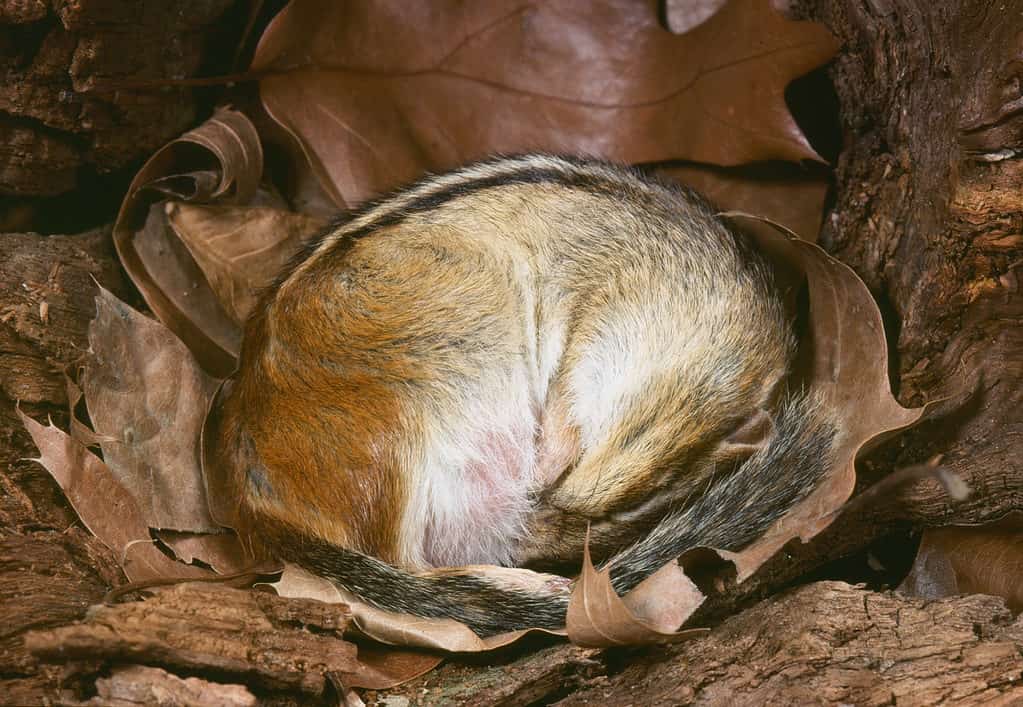
Eastern chipmunks enter a state of torpor to survive the cold winter in their cozy burrows.
©Breck P. Kent/Shutterstock.com
Eastern chipmunks are solitary and most active during the middle of the morning and the middle of the afternoon. They spend nearly all of their time looking for food to get them through winter torpor, to fatten themselves up, and to collect nuts and seeds and cache them.
Eastern chipmunks are agile climbers of trees and have a squirrel’s anatomical adaptations that let them climb down headfirst. Yet, they are considered ground squirrels because they sometimes build elaborate burrows with rooms and tunnels that have different entrances and exits.
Burrows are found in the center of the chipmunk’s home range. It is usually less than three feet deep and the tunnels connect with each other and can be 33 feet long. The chipmunks camouflage their burrows by adding leaves, rocks, sticks, and other objects to the entrances. The nest itself is made out of shredded leaves. Chipmunks are territorial and will aggressively defend their burrows.
In the winter, while it is experiencing torpor, a chipmunk will wake up now and then to feed on its stores of seeds and nuts. On warmer days, it’ll even come out of its burrow to forage. It takes the chipmunk hours to wake up from its winter slumber.
The rodent also has an interesting repertoire of calls. Scientists classify them as chips, chucks, squeals, chatters, and trills.
Habitat
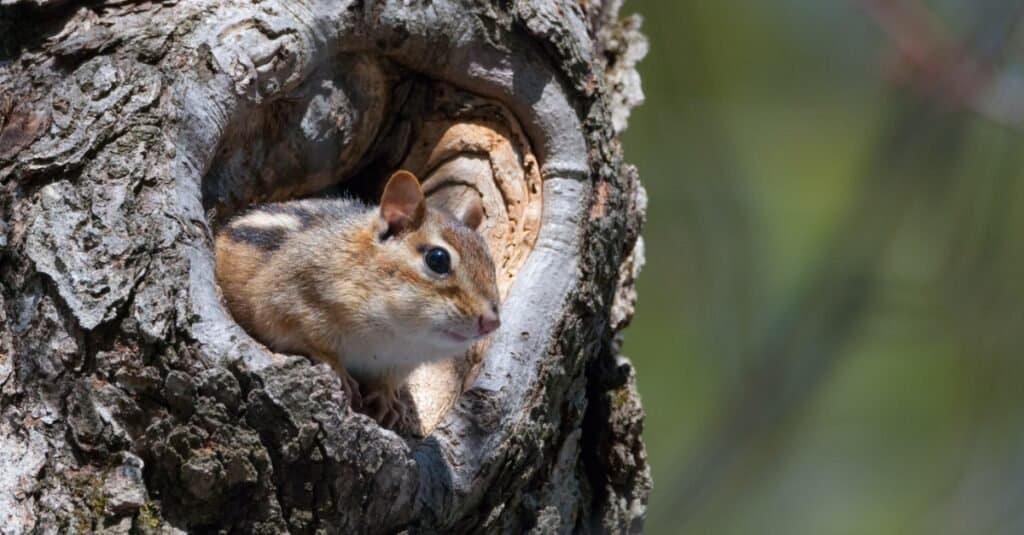
The favorite habitat of an Eastern chipmunk is old forests but any bit of land with a few trees and shrubs will do.
©iStock.com/Kyle Bedell
Eastern chipmunks are fond of city parks, river valleys, and deciduous woods found in the south of Canada and down through the eastern part of the United States. Their favorite habitat is old forests made largely of beeches and maples, and they dig their burrows under buildings, crags, log piles, and shrubs. The size of their home range depends on the time of year. It’s largest in early summer to early fall and smallest in spring and winter.
Diet
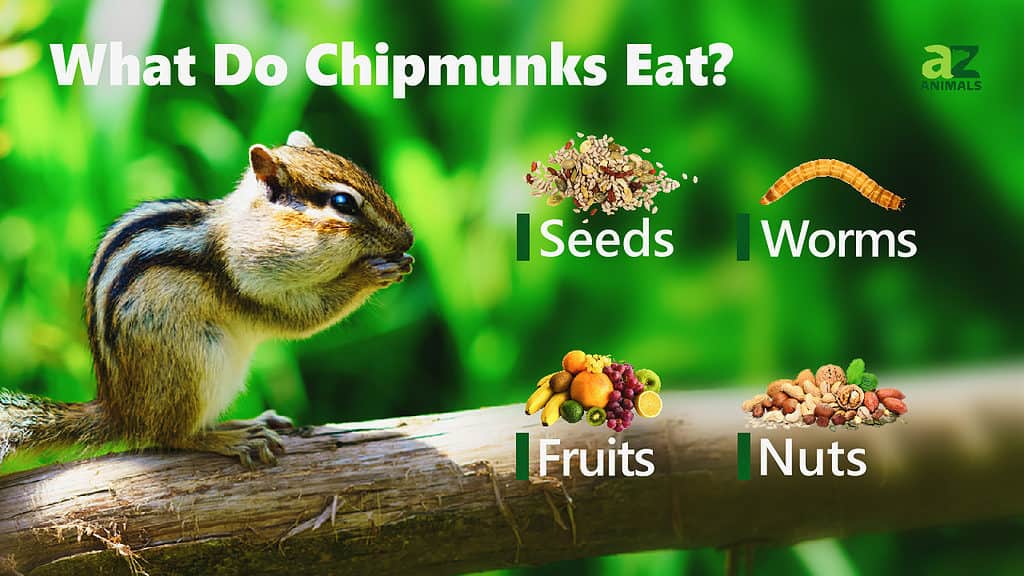
Eastern chipmunks are largely herbivores, but they will also eat bird eggs, slugs, worms, and insects. When it comes to plant material, they famously eat seeds, mushrooms, bulbs, nuts, fruit, and green leafy plants. They cache nuts and seeds all year, but the behavior picks up in the fall just before the rodent goes into its not-quite hibernation.
Despite their foraging for seeds, eastern chipmunks do not seem to cause too much harm to crops. Now and then they’ll scatter some seeds, and some of them will germinate. Since chipmunks eat insects, they may help control the pest population.
Predators and Threats

Domesticated cats enjoy keeping chipmunk populations in check.
©Diana Golysheva/Shutterstock.com
The eastern chipmunk is the perfect prey for a variety of predators. It is harmless, easy to catch, and provides a good meal for a medium-sized carnivore. Because eastern chipmunks are so abundant, predation keeps their numbers in balance. Predators include red-tailed hawks, owls, raccoons, red squirrels, mustelids such as fishers and ermines, bobcats, coyotes, and pet dogs and cats.
Reproduction and Life Cycle
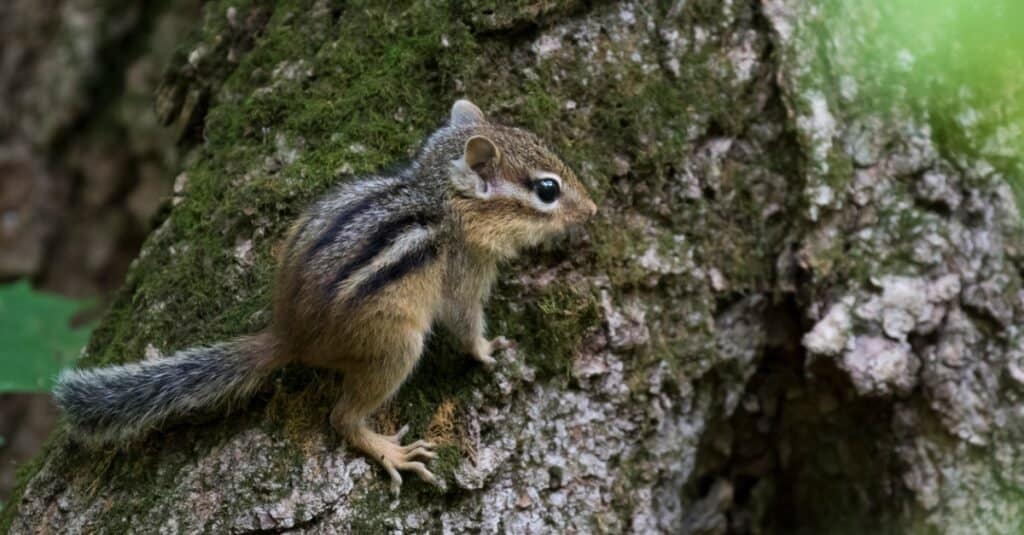
Baby eastern chipmunks are born into litters of two to five pups and are totally dependent on their mothers for two months.
©iStock.com/mirceax
Eastern chipmunks only tolerate each other during the breeding season and of course when a mother is raising her pups. They have two breeding seasons. One lasts between February and April and the other lasts between June and August. They are promiscuous and have several mates during the female’s period of estrous. During that time she’ll stay in her home range, and the males will seek her out.
After a pregnancy of about 35 days, the female chipmunk gives birth to two to five pups in her burrow. They are naked, blind, and helpless and have a weight of about a tenth of an ounce. They are weaned after about 40 days. The pups are independent when they’re about two months old, and females are ready to breed themselves when they’re about six months old. Males are ready when they’re about eight months old. Though most chipmunks don’t live past two years, they can have a lifespan of as long as eight years in the wild.
Population
Though there are no set numbers, the eastern chipmunk is widespread within its range, and its IUCN listing is least concern.
View all 117 animals that start with EEastern Chipmunk FAQs (Frequently Asked Questions)
Are Eastern Chipmunks carnivores, herbivores, or omnivores?
They are mostly herbivores, though they’ll also eat worms, insects, and bird’s eggs.
What does an Eastern chipmunk eat?
Besides the animal matter mentioned, the chipmunk eats seeds, nuts, mushrooms, bulbs, fruit, and green plants.
How do I tell a male Eastern chipmunk from a female?
Telling male and female eastern chipmunks from each other by sight is difficult. The best way to tell is to observe them during the breeding season. Male chipmunks leave their burrows to visit the burrows of the females. An adult chipmunk who can tolerate being around juvenile chipmunks is invariably their mother.
How does the Eastern chipmunk adapt to the winter?
One of the more interesting adaptations the eastern chipmunk has made to winter is to hoard lots of seeds and nuts in its burrow. It needs to do this because it does not properly hibernate but goes into a state called torpor. During torpor, it can wake up now and then to eat or even go outside. An animal that is in a state of proper hibernation stays that way for months at a time and doesn’t really wake up. These animals also store fat to get them through this period.
Is the eastern chipmunk endangered?
This chipmunk is not at all endangered and is abundant where it is found.
How can you tell an eastern chipmunk?
One help in the identification of the eastern chipmunk is to measure it against other chipmunks, all of whom are smaller than it is. The colors of the fur may be different shades or distributed in different places over the body. More importantly, the stripes on the eastern chipmunk’s body stop at the patch on its rump. In other chipmunks, the stripes run down to the base of the tail.
How big is an eastern chipmunk?
This chipmunk can grow to as much as a foot in length, including the tail.
Thank you for reading! Have some feedback for us? Contact the AZ Animals editorial team.
Sources
- ITIS / Accessed January 30, 2022
- Wikipedia / Accessed January 30, 2022
- LiveScience / Accessed January 30, 2022
- Simon & Schuster / Accessed January 30, 2022
- ESF / Accessed January 30, 2022
- GA Department of Natural Resources / Accessed January 30, 2022
- IUCN / Accessed January 30, 2022


















